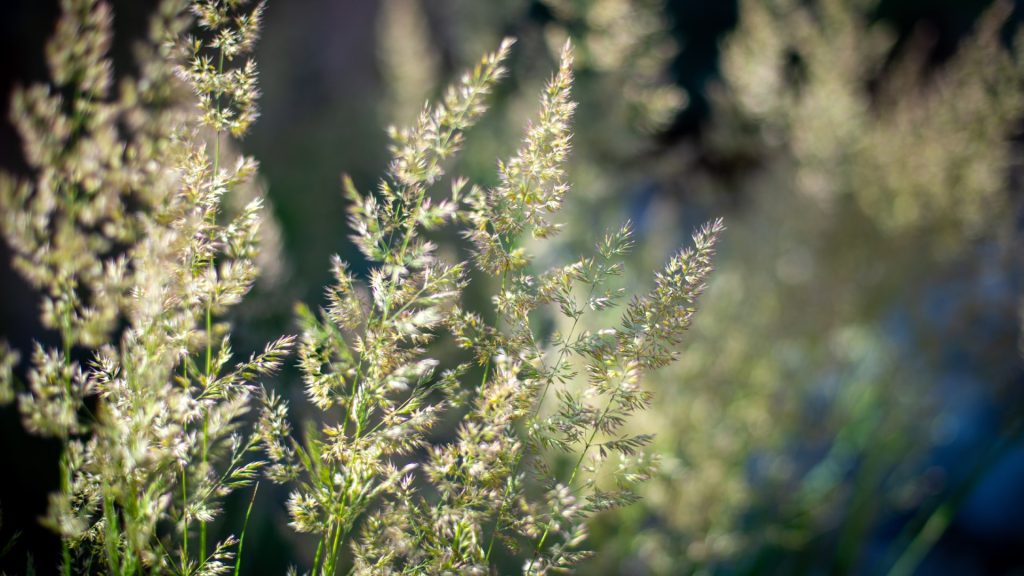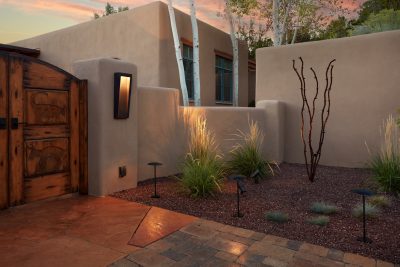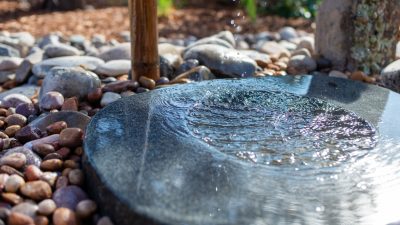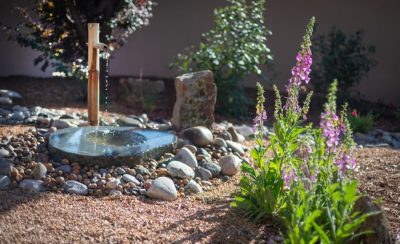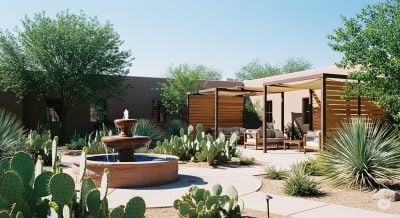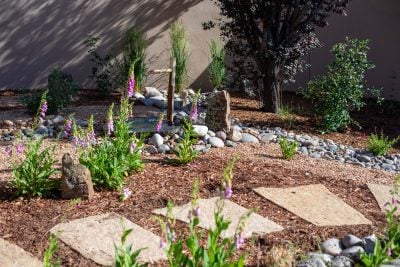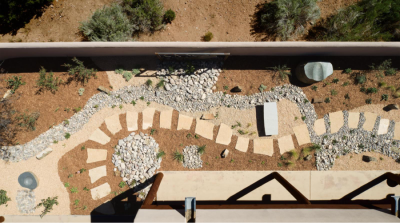Drought Tolerant Landscaping: Key Takeaways
- You can use various drought-tolerant landscaping ideas for your outdoor space, from native grass meadows and Mediterranean gardens to cactus displays and dry creek beds
- Drought-tolerant landscapes create beautiful gardens that thrive in the dry, high-desert Santa Fe conditions
- Native and drought-resistant plants support sustainability and require minimal maintenance
- To create a drought-tolerant landscape, assess your site, improve soil, and use efficient irrigation systems
330 gallons: that’s what it takes to water a 1,000-square-foot lawn just once. This can be critical for a high-desert city like Santa Fe, where every drop counts.
Desert landscaping offers a smarter, low-water alternative. And yes, the effect can be stunning.
We’ll share:
- Creative drought-tolerant landscaping ideas for Santa Fe yards
- Benefits of choosing drought-tolerant landscapes
- How to design and maintain a low-water landscape
6 Drought-Tolerant Landscaping Ideas
Maybe you think water-wise gardens are unattractive? Think again, and we’re sure some awesome designs will come to mind.
To set your imagination working, we’ve also compiled six innovative ideas for an outdoor space that thrives in dry conditions.
1. Native Grass Meadow
Want to recreate the open, untamed feel of a prairie? A native grass meadow can do it, in a few easy steps.
Clear existing vegetation and debris and add compost to the soil to improve water retention.
Plant native grasses like Blue Grama and Buffalo Grass. The best time to do it is early spring or fall. For more insights on the importance of planting times, check out our guide.
The next steps will include:
- Watering until the plants are well-rooted, then sprinkling occasionally.
- Mowing once or twice a year to keep the natural look and prevent weed growth.
2. Mediterranean-Style Garden
Craft a cozy, inviting space that captures the charm of Mediterranean coastlines with aromatic herbs and vibrant colors.
One way to get this look is by planting drought-tolerant herbs and plants such as lavender, rosemary, and olive trees.
Group them in clusters of varying heights and textures to create movement and enhance their beauty. To direct water to plant roots, opt for a drip irrigation system.
For an extra touch of Mediterranean vibe, add terracotta pots and rustic stone elements.
3. Succulent & Cactus Display
Bring a touch of the desert to your garden and enjoy a low-maintenance, yet visually appealing landscape.
Plant hardy beauties like agave, aloe, and barrel cactus in roomy beds or large containers. Once planted, let the soil dry out fully before watering.
4. Zen Garden
Set a tranquil, contemplative space for meditation and relaxation. Here’s how to get started:
- Choose a quiet, secluded area in your garden.
- Add a bench or seating area where you can unwind early in the morning or after work.
- Mix raked gravel and rocks of different sizes with plants like Japanese maple or bamboo.
Don’t forget to rake the gravel into patterns regularly and prune plants so they are beautiful in all seasons.
5. Dry Creek Bed With Sculptural Stones
Dry creek beds offer a dramatic vibe. And you can make them faster than you’d think. All you need to do is:
- Dig a shallow trench along the natural slope of your yard.
- Line it with landscape fabric to stop weeds and erosion.
- Fill the trench with gravel, river rocks, and larger stones, grouping the biggest stones to create focal points.
- Plant drought-tolerant grasses along the edges to soften the look.
6. Rock Garden With Cascading Water Feature
This serene landscape idea blends the beauty of rocks with the soothing sound of water. Here’s how to bring it to life:
- Choose where you’ll have your water feature.
- Use a recirculating pump to keep water flowing.
- Arrange rocks of various sizes to form a natural-looking cascade: think how magical this will be as water flows over them.
- Add ferns, mosses, and grasses to boost the effect.
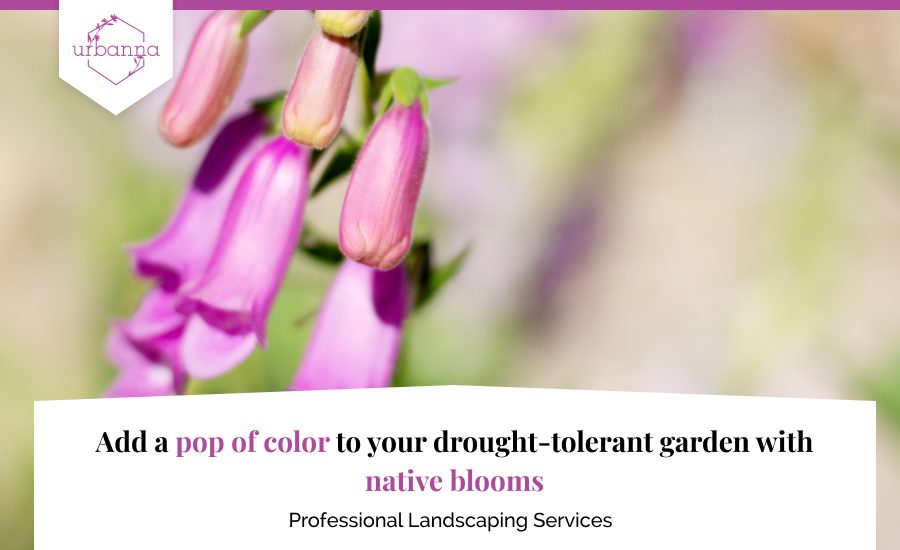
Understanding Drought-Tolerant Landscaping
Drought-tolerant landscaping is the process of creating outdoor projects with plants that can withstand extended dry spells.
This approach is particularly beneficial in arid or semi-arid regions, such as Santa Fe, where water conservation is crucial.
In the next section, we will explore the advantages of drought-tolerant landscaping.
Benefits of Drought-Tolerant Landscaping
Drought-resistant landscapes offer several significant benefits:
Water Conservation
A typical lawn requires over 1,000 gallons of water per week in summer, while waterwise plants only need a portion of that, relying primarily on natural rainfall.
Reduced Maintenance
Drought-tolerant landscaping requires less effort compared to traditional gardens, where you’d spend hours and days watering and pruning.
Groundcovers like Blue Grama don’t need regular mowing and trimming, while plants like Penstemon can handle extreme temperatures and prolonged dry periods, which keeps garden chores at a minimum.
Cost Savings
Replacing a traditional grass lawn with a Santa Fe xeriscape garden (you can use yucca as an accent!) can reduce water bills by up to 50%.
Additionally, lower maintenance will lead to savings on garden services and supplies.
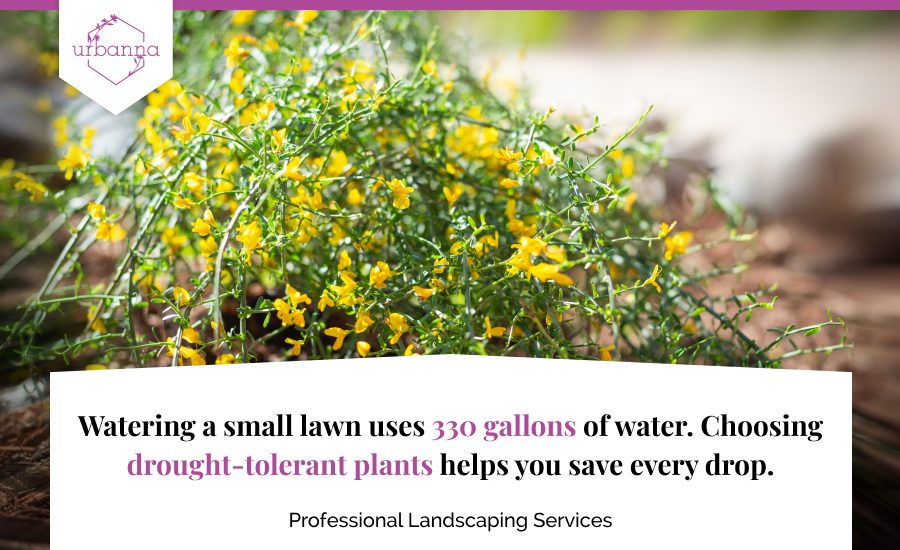
Drought-Tolerant Landscaping and Sustainable Gardening
Drought-tolerant landscaping plays an important role in sustainable gardening, aligning garden practices with environmental goals.
Using native plants that require little watering reduces the strain on local water resources.
These plants are typically more resilient to pests and diseases, which means fewer chemical fertilizers and pesticides.
Less maintenance means you’ll use gasoline-powered tools less often, helping reduce carbon emissions.
How To Design a Drought-Tolerant Landscape
Creating a drought-tolerant landscape requires careful planning and selection of plants and materials.
Here are the key steps to designing your project:
Assess Your Site
Is your soil loose and sandy, or dense like clay? Drainage is key, so watch how water behaves after a good soak.
Another thing to consider is how much sunlight each area receives at different times of the day.
Plan Your Layout
- Group plants with similar water requirements to maximize efficiency.
- Use rocks and gravel to reduce water use.
- Add intriguing visual elements for a stronger impact.
Select Drought-Tolerant Plants
Arrange native plants, shrubs, perennials, and groundcovers to shape a diverse, colorful, and resilient landscape.
Improve Soil Quality
Compost and mulch are your secret weapons. A layer of each can boost moisture retention, keep weeds in check, and give your plants a great start.
Install Efficient Irrigation
- Implement drip irrigation systems so water reaches the plant roots directly.
- Use timers and sensors to optimize watering schedules and avoid overwatering.
Use Water Conservation Techniques
- Collect and store rainwater in barrels or cisterns for irrigation.
- Consider using greywater from sinks, showers, and washing machines.
Maintain Your Landscape
- Check your irrigation for leaks to ensure an adequate water supply.
- Prune plants and replenish mulch to keep your plants healthy and maintain soil moisture.
Create Drought-Tolerant Landscapes With Urbanna Landscaping
At Urbanna Landscaping, we are dedicated to helping homeowners enjoy beautiful, sustainable, drought-tolerant landscapes that thrive in Santa Fe’s unique climate.
We offer a comprehensive range of services, from Santa Fe-specific landscaping and hardscaping to lighting and efficient irrigation systems.
Whether you want to design a Zen garden, Mediterranean-styled landscape, or striking succulent and cactus display, we offer tailored solutions to keep your garden inspiring throughout every season.
Get in touch, and we will help you enhance the natural beauty of your Santa Fe home.
FAQs About Drought-Resistant Landscaping
Is drought-tolerant landscaping expensive?
While the initial costs for drought-tolerant landscaping may be slightly higher than traditional landscapes, the long-term savings on water bills and maintenance often outweigh the upfront expenses.
Is drought-tolerant landscaping attractive?
Definitely. Just think how a well-placed agave framed by stones or a mix of native grasses can change the entire look of your yard. These gardens can be both low-maintenance and breathtaking.
What types of mulch can I use for drought-tolerant landscapes?
You can use both organic and inorganic mulches. Organic ones, like wood chips, bark, or straw, help retain soil moisture and add nutrients, while inorganic mulches like gravel or rocks help reduce evaporation and prevent weed growth.
How can I transform my existing landscape into a drought-tolerant one?
To transform your existing landscape into a drought-tolerant one, remove plants that need regular watering and replace them with drought-tolerant species. Adjust your irrigation system to improve efficiency and amend the soil for better water retention.
How long does it take to establish a drought-tolerant landscape?
It depends on your plant choices. Most native species take one growing season to get established.
Will my garden look bare in the winter?
Not at all. Use evergreen succulents, ornamental grasses, and woody shrubs that remain beautiful in winter, giving your outdoor space year-round texture and interest.
Is xeriscaping the same as drought-tolerant landscaping?
Xeriscaping is a specific approach to water-wise landscaping that often uses drought-tolerant plants, but they’re not always the same. Xeriscaping follows a set of design principles, while drought-tolerant landscaping can be more flexible.
- What’s Included in a Residential Landscaping Project in Santa Fe? - September 26, 2025
- Desert Landscape Ideas: Modern, Drought-Tolerant Designs - September 25, 2025
- Drought-Tolerant Landscaping Ideas for Low-Maintenance Yards - September 23, 2025
